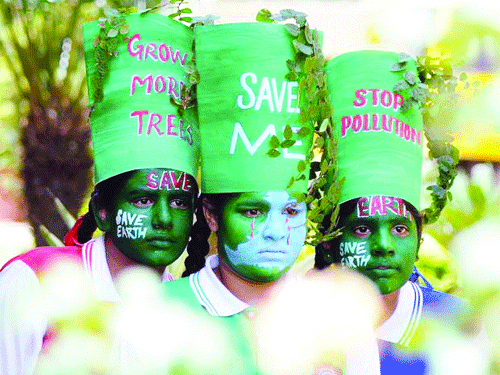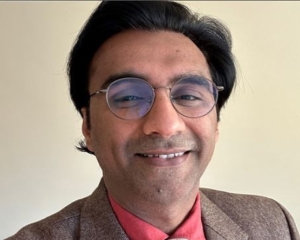While we observe Earth Day in India in 2016, we need to reflect on the mindless damage that we are carrying out on the ecosystems of the planet, the disadvantage we are increasing for the poorest of the poor
Organisations and people round the world celebrate Earth Day on April 22 each year, but it is not clear if all those participating in this event are fully aware of the threats that human society is imposing on Planet Earth and how this particular day became a global event 46 years ago. The reality is that human activities have progressively expanded their footprint on the earth’s ecosystems to a point where they are leading to rapid damage and degradation of the very support systems that sustain all forms of life on this planet. In itself, the huge increase in human population may not have posed a global threat if it were not for the fact that the spread of uniform aspirations to consume more and more is leading to the production of goods and services that are leading to pollution of the air that we breathe, the water that we drink, the food that we eat and to an increase in the use of toxic substances in many products, all of which lead to health hazards for across the globe.
The living Planet Report brought out annually by WWF estimated in its 2014 version that for 40 years in the immediate past, humanity’s demand has exceeded the earth’s bio-capacity. It estimated that we need 1.5 earths to meet the demand humanity currently makes on nature. Forests, which are being destroyed across the world, and seriously degraded in India as well, provide shelter, livelihoods, water, fuel and food to two billion people. Environmental damage, therefore, damages the welfare of the poor. Perhaps, the most serious threat resulting from our unsustainable pattern of growth and development emanates in the form of human induced climate change. The Intergovernmental Panel on Climate Change, which I had the privilege of chairing for 13 years, has in its Fifth Assessment Report, brought out the extent and nature of climate change taking place across the globe, the intensity and seriousness of its impacts and the means by which the challenge can be met through a combination of adaptation as well as mitigation measures, which the world must implement with a sense of urgency. The IPCC was established in 1988, but concerns about the damage we are inflicting on the planet began to be articulated much earlier through the work of pioneers like Rachel Carson, whose book, Silent Spring, shocked the US on the extent to which toxic substances were being produced and released into the soil, air and water streams of that country. However, the credit for bringing environmental issues into the domain of policymaking and collective public action, particularly in the US, goes to a remarkable leader, the late Senator Gaylord Nelson.
Gaylord Nelson was a visionary and a crusader who realised that legislation on environmental issues presents certain limits, and therefore what would work in practice is action by the public. It is reported that Nelson, while cognizant of the prosperity that some achieved in the US during the 1950s, never lost sight of those in the cities and countryside who were disadvantaged. He was also fully conscious of the social and ecological implications and costs of technological innovation and industrial expansion. Once he entered the US Senate, he worked with President John F Kennedy to undertake a tour of the country for conservation and the environment. He also worked closely with President lyndon B Johnson to advance civil rights legislation and the fight against poverty. While in India, we have not fully understood the nexus between environmental degradation and poverty, he saw the fight against poverty as an essential part of his environmental agenda. He believed that “environment is all of America and its problems. It is rats in the ghetto. It is a hungry child in a land of affluence. It is housing not worthy of the name; neighborhoods not fit to inhabit”. In some sense, this echoed Prime Minister Indira Gandhi’s reference to poverty being the worst polluter, while addressing the UN Conference for the Human Environment in Stockholm in 1972, when she stated, “Are not poverty and need the greatest pollutersIJ” She added further, “It would be ironic if the fight against pollution were to be converted into another business, out of which a few companies, corporations or nations would make profits at the cost of the many.” Gaylord Nelson believed that environmental protection did not have to be at odds with economic development, and in his efforts the record shows that he pushed programmes like Operation Mainstream, allowing for appropriation of millions of dollars meant for creating conservation jobs and skills training for the poor and the elderly under what he labelled as the Green Thumb project. Interestingly, as Chairman of the US Senate’s Select Committee on Small Business, he referred to the work of a middle level official in the Government of Uttar Pradesh, by the name of Ram Bux Singh, who did pioneering work in that State in the establishment and upkeep of biogas plants. The record of the Senate holds references to Ram Bux Singh’s work in the form of an ‘Interview with India’s Gobar Gas Expert, Ram Bux Singh’, which Senator Nelson introduced and discussed in 1975.
Not satisfied with Government decisions and actions, Gaylord Nelson decided in 1969 to call for a day when the whole of the US would arrange teach-ins to raise awareness among the public on environmental problems. The media and communities on the country’s campuses responded enthusiastically to this call and termed the intended day as Earth Day. Nelson set up a small office to coordinate activities that were planned, and put a young 26-year old Denis Hayes as the head of his establishment. He, however, shunned a top-down approach, and appealed to the public to organise themselves at the local level to ask for action from their officials on what had to be done to protect the environment around them. On April 22, 1970, an estimated 20 million Americans, young and old, were reported to have become an active part of this event by gathering together to highlight the ecological problems in their cities, states, the nation, and planet earth — and to demand action from themselves and from their elected officials. With the resounding success of the very first Earth Day celebration in 1970, Denis Hayes set up the Earth Day Network, which extended to 180 countries, and created the Earth Day into a global event.
While we observe Earth Day in India in 2016, we need to reflect on the mindless damage that we are carrying out on the ecosystems of the planet, the disadvantage we are increasing for the poorest of the poor. This is a day when the youth of the nation in particular must organise to join hands and change direction, so that the pattern of development we pursue is truly sustainable.
Earth Day 2016 should be a day when the youth of the world take the environmental destiny of this planet into their own hands. The youth must lead in the fight for sustainable development.
























